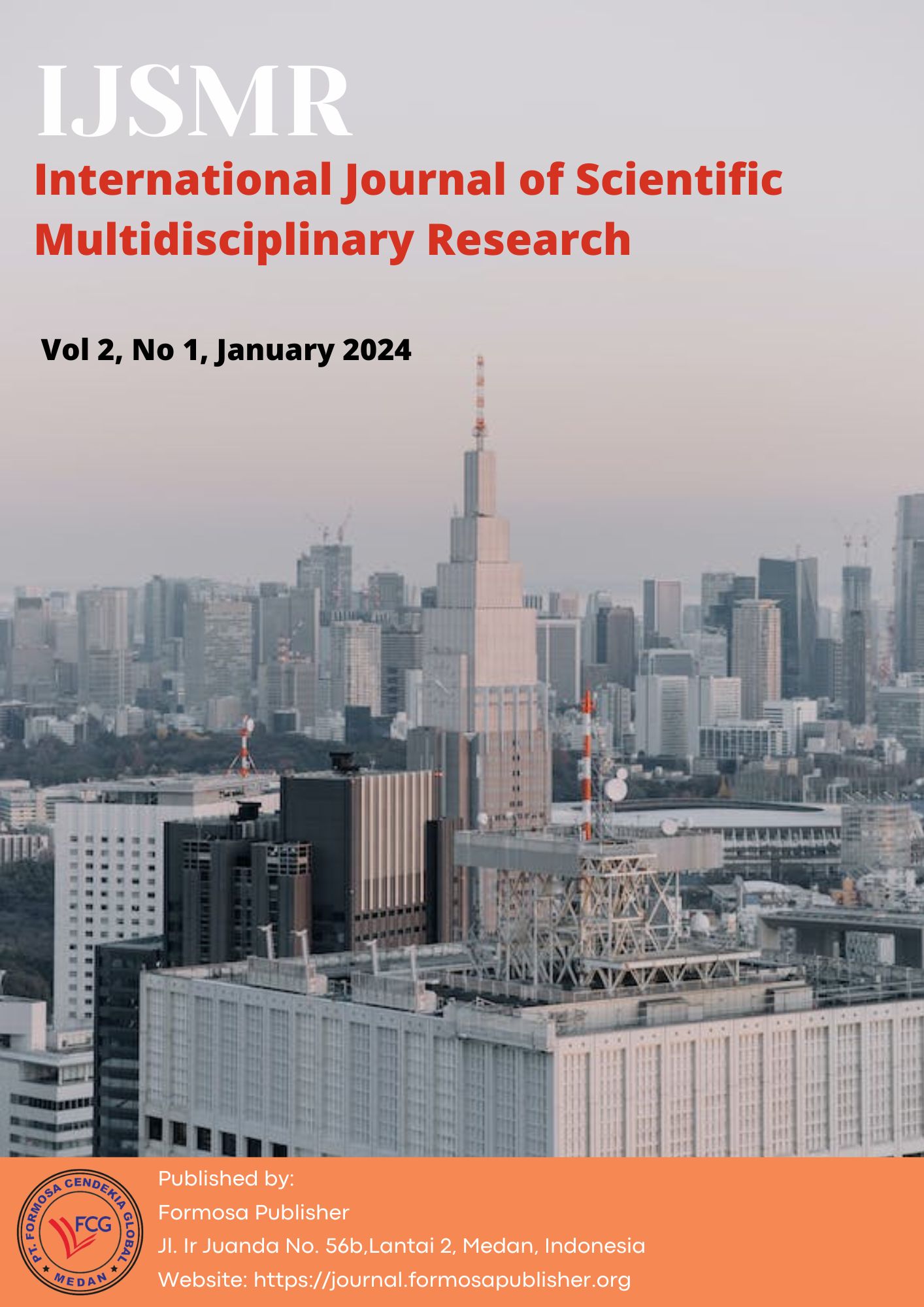Puerperium and Lactation: The Crucial Phases of Maternal and Infant Health
DOI:
https://doi.org/10.55927/ijsmr.v2i1.7026Keywords:
Puerperium, Lactation, Postpartum PeriodAbstract
Puerperium and lactation are critical phases in a woman's life and are characterized by profound physiological and psychological changes. The puerperium, commonly known as the postpartum period, refers to the number of weeks following childbirth when a woman's body undergoes a series of adjustments to return to its non-pregnant state. This phase typically lasts for approximately six weeks but can vary from woman to woman. During puerperium, the uterus contracts, lochia (postpartum discharge) is expelled, and the body gradually recovers from the stress of pregnancy and childbirth. Emotional well-being is also an essential aspect of puerperium, as women often experience a range of emotions and adjustment challenges. Conversely, lactation is the process of producing and providing breast milk to the infants. It is a unique and essential aspect of motherhood, offering numerous health benefits for both the mother and baby. Lactation is primarily regulated by hormones, such as prolactin and oxytocin. Prolactin stimulates milk production, whereas oxytocin triggers milk ejection during breastfeeding. During lactation, the mother's body provides infants with vital nutrients, immunological protection, and emotional bonds through breastfeeding. This natural process also promotes uterine involution, helping the mother recover more quickly after childbirth. Furthermore, breastfeeding has far-reaching health benefits, reducing the risk of various diseases in both mothers and babies
Downloads
References
Anderson JW, Johnstone BM and Remley DT (1999). Breastfeeding and cognitive development: a meta-evaluation Am J Clin Nutri 70, 525–35.
Bofill JA, Rust OA, Schorr SJ, et al. (1996) A randomized prospective trial of the obstetric forceps as opposed to the M-cup vacuum extractor Am J Obstet Gynecol 175, 1325–30.
Confidential Enquiry into Maternal and infant health (2004) Why moms die 2000–2002 London: RCOG Press.
Chaliha C. & Stanton SL. (2002). Urological troubles in pregnancy. BJU Worldwide 89, 469–76.
Collaborative organization on breast cancer and breastfeeding: Collaborative analysis of person facts from 47 epidemiological studies in 30 countries includes 50302 ladies with breast cancer and 96973 girls without the disease. (2002) Lancet 360, 187–95.
Davis, M.ok. (1998), a personal overview of the evidence for an association Between infant feeding and adolescence, most cancers Int J most cancers Suppl. 11, 29–33.
Dewey KG (2004) Impact of breast feeding on maternal dietary reputation. Adv Exp Med Biol 554, 91–100.
Donnelly VS, Fynes M, & Campbell D (1998) Obstetric activities leading to anal sphincter harm Obstet Gynecol 92, 955–61.
Dunlop, W. (1989), The Puerperium, Fetal Med Rev 1, 43–60.
Gerstein HC (1994): Cow’s milk publicity and type I diabetes mellitus An essential evaluation of the medical literature Diabetes Care 17, 13–19.
Greer, IA (2003) Prevention of venous thromboembolism in pregnancy first-class Pract Res Clin Haematol 16, 261–78.
Glazener CM, Herbison GP, Macarthur C, et al. (2004) A randomized controlled trial of conservative management of natal urinary incontinence and fecal incontinence: 6-month follow-up Br Med J 12 (Dec), doi:10.1136/bmj.38320.613461.82.
Glazener CM, MacArthur C, & Garcia J (1993). Postnatal care: time for an alternate. Contemp Rev Obstet Gynecol 5, 130–6.
Howie PW, Forsyth JS, Ogston SA, et al. (1990): shielding effect of b against infection Br Med J 300, 11–16.
Johansson RB, Rice C, & Doyle MA (1993) A randomized potential look at comparing the brand new vacuum extractor policy with forceps transport Br J Obstet Gynecol 100, 524–30.
Kovacs GT (1985): Submit partum fertility: a review with Clin Reprod Fertil 3, 107–14.
Larson-Meyer DE (2002) effect of submit partum exercise on moms and their offspring. Obes Res 10, 841–53.
Lucas, A., Morley, R., Cole, T.J., et al. (1992). Breast milk and the next intelligence quotient in youngsters born preterm Lancet 339, 261-4.
Martin RM, Ness AR, Gunnell D, et al. (2004) Does breastfeeding in infancy lower blood stress in adolescence? The Avon Longitudinal Look at Dad, Mom, and Kids (ALSPAC). movement 109, 1259–66.
Morrow-Tlucak M, Haude RH, & Ernhart CB (1988). Breastfeeding and cognitive improvement in the first 2 years of life. Soc Sci Med 26, 635–9.
Oddy WH, Peat JK, & de Klerk NH (2002) Maternal allergies, child feeding, and the danger of asthma in early life J hypersensitivity Clin Immunol 110, 65–67.
Oppenheimer LW, Sherriff EA, Goodman JD, et al. (1986): The Period of Lochia Br J Obstet Gynecol 93, 754–7.
Renfrew M. Fisher C. & Fingers S. (1990), Breast Feeding: Getting Breastfeeding is Appropriate for You Berkeley, CA: Celestial Arts.
Rooney BL & Schauberger CW (2002) Extra pregnancy weight gain and long-term obesity: one decade later Obstet Gynecol one hundred, 245–52.
Sultan AH, Kamm MA, Hudson CN, et al. (1993): Anal-sphincter disruption at some stage in vaginal shipping N Eng J Med 329, 1905–11.
Sultan AH (2002), third-diploma tear restore, in McJean AB (ed.), Incontinence in Ladies London: RCOG Press, 379–90.
Shehata HA and Nelson Piercy C (2001): capsules in pregnancy satisfactory Pract Clin Obstet Gynecol 15, 971–86.
UNICEF Child pleasant Initiative (2005) www.babyfriendly.org.united kingdom
Vestergaard M, Obel C, Henriksen TB, et al. (1999) Duration of breastfeeding and developmental milestones at some stage in the latter half of infancy Acta Pediatrica 88, 1327–32.
Von Kries R, Koletzko B, Sauerwald T, et al. (1999) Breastfeeding and obesity: a cross-sectional take a look at Br Med J 319, 147–50.
Downloads
Published
How to Cite
Issue
Section
License
Copyright (c) 2024 Rehan Haider, Asghar Mehdi, Anjum Zehra

This work is licensed under a Creative Commons Attribution 4.0 International License.
















